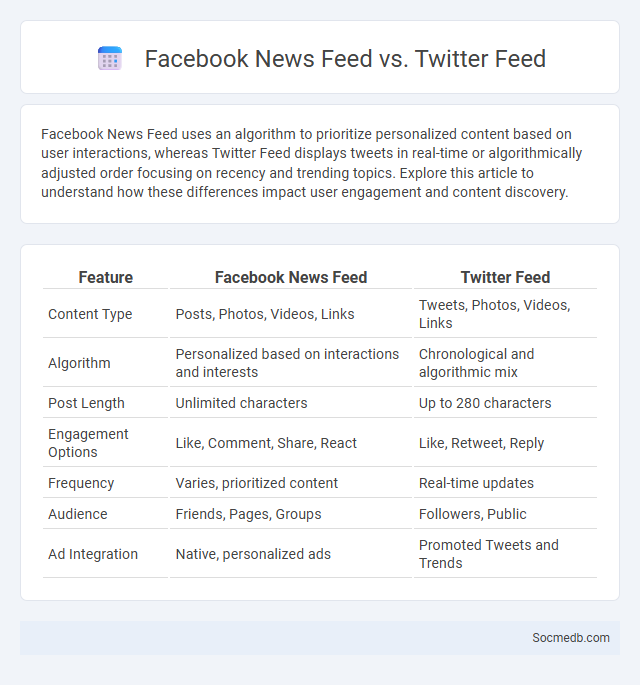
Photo illustration: Facebook News Feed vs Twitter Feed
Facebook News Feed uses an algorithm to prioritize personalized content based on user interactions, whereas Twitter Feed displays tweets in real-time or algorithmically adjusted order focusing on recency and trending topics. Explore this article to understand how these differences impact user engagement and content discovery.
Table of Comparison
| Feature | Facebook News Feed | Twitter Feed |
|---|---|---|
| Content Type | Posts, Photos, Videos, Links | Tweets, Photos, Videos, Links |
| Algorithm | Personalized based on interactions and interests | Chronological and algorithmic mix |
| Post Length | Unlimited characters | Up to 280 characters |
| Engagement Options | Like, Comment, Share, React | Like, Retweet, Reply |
| Frequency | Varies, prioritized content | Real-time updates |
| Audience | Friends, Pages, Groups | Followers, Public |
| Ad Integration | Native, personalized ads | Promoted Tweets and Trends |
Introduction to Social Media News Feeds
Social media news feeds aggregate real-time updates, posts, and multimedia content from users and followed pages, creating a personalized stream of information. Algorithms prioritize content based on user interactions, preferences, and trending topics to enhance engagement and relevance. This dynamic content delivery system helps users stay informed, connected, and entertained across platforms like Facebook, Instagram, and Twitter.
What is the Facebook News Feed?
The Facebook News Feed is a dynamic, personalized stream of updates, posts, and stories from your friends, pages you follow, and groups you join, designed to keep you informed and engaged. It uses an algorithm that prioritizes content based on your interactions, preferences, and relevance, delivering a tailored social media experience. Your News Feed continuously evolves to highlight the most meaningful and timely information, maximizing your connection to the Facebook community.
What is the Twitter Feed?
The Twitter feed is a continuously updated stream of tweets from accounts you follow, displaying real-time posts, retweets, and replies. Your Twitter feed includes multimedia content, trending topics, and personalized recommendations powered by Twitter's algorithm to enhance engagement. Understanding how the Twitter feed works enables you to curate valuable information and stay connected with relevant conversations.
Understanding the Generic News Feed
The Generic News Feed on social media platforms curates content based on algorithms that analyze user behavior, preferences, and engagement patterns to deliver personalized updates. Your interaction history and network connections heavily influence the types of posts, ads, and stories you see, optimizing relevance and engagement. Understanding these algorithmic dynamics empowers you to tailor your content visibility and enhance your overall social media experience.
Key Differences: Facebook vs Twitter Feed
Facebook feeds prioritize rich multimedia content such as photos, videos, and detailed posts, while Twitter focuses on brief, real-time updates limited to 280 characters. Your Facebook feed algorithm emphasizes personal connections and engagement through comments and reactions, whereas Twitter's feed highlights trending topics and hashtags for quick information dissemination. Understanding these key differences allows you to tailor your social media strategy effectively across both platforms.
Content Algorithms: Facebook vs Twitter
Facebook's content algorithm prioritizes personalized user engagement by analyzing factors such as post popularity, user interaction history, and content type, resulting in a highly tailored news feed. Twitter's algorithm emphasizes recency and relevance, using real-time data and trending topics to surface tweets that encourage timely conversations and viral content sharing. Both platforms leverage machine learning models to optimize content visibility, but Facebook focuses more on sustained user interaction while Twitter targets immediate information dissemination.
User Engagement: Facebook, Twitter, and News Feed
User engagement on Facebook, Twitter, and News Feed significantly drives platform activity by encouraging likes, comments, and shares. Facebook's algorithm prioritizes personalized content in News Feed to keep users connected and active, while Twitter enhances interaction through real-time updates and trending topics. Optimizing content for these platforms boosts visibility and fosters community growth.
Personalization Features Compared
Personalization features on social media platforms vary widely in their ability to tailor content to user preferences, leveraging algorithms that analyze your interests, interactions, and demographic data. Platforms like Instagram and TikTok excel in using AI-driven recommendations to curate personalized feeds, while Facebook offers advanced customization through groups and targeted ads. Your experience is enhanced through these features, which increase engagement by delivering relevant content and advertisements based on your unique online behavior.
Pros and Cons of Each News Feed
Facebook's news feed offers personalized content driven by an extensive algorithm, enhancing user engagement through targeted posts and advertisements, but it often leads to echo chambers and privacy concerns. Twitter's feed excels in real-time updates and trending topics, promoting rapid information dissemination while also encouraging brief interactions that may lack depth and context. Instagram prioritizes visual storytelling with an emphasis on photos and videos, fostering creativity and brand visibility; however, it can contribute to unrealistic social comparisons and mental health issues due to curated content.
Choosing the Best Platform for News Consumption
Selecting the best social media platform for news consumption depends on factors such as content credibility, user engagement, and update frequency. Twitter excels in real-time news updates and trending topics, while Facebook offers diverse sources and community discussions. Instagram and TikTok provide visual storytelling but require careful evaluation of sources for accurate information.
 socmedb.com
socmedb.com